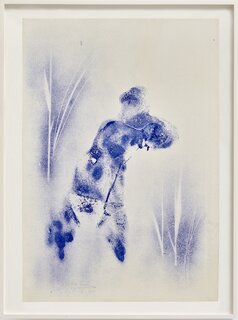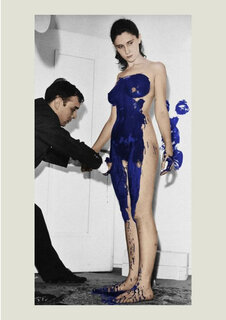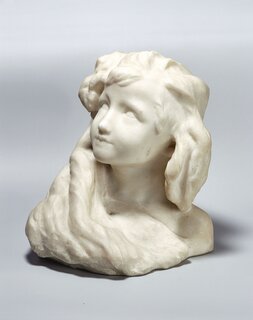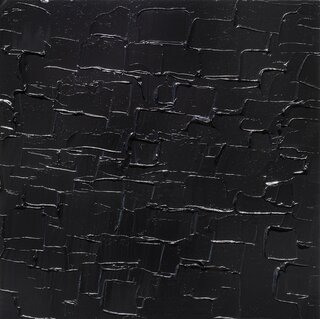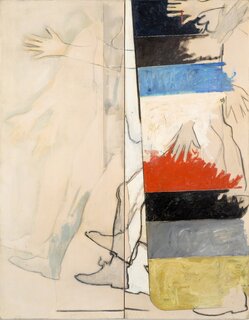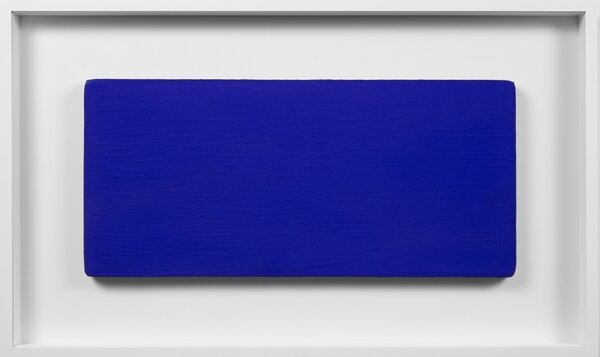
"The painting is only the witness, the sensitive plate that has seen what has
happened. Color, in the chemical form in which all painters use it, is the medium best suited to the event. Therefore I can say: My pictures represent poetic events or, rather, they are immobile, silent and static witnesses to the very essence of movement and life in freedom, which is the flame of poetry in the pictorial
moment!
— Yves Klein, ""L'Aventure monochrome,"" Le Dépassement de la problématique de l'art et autres écrits, 1958
Untitled Blue Monochrome (IKB 241) is a product of Klein’s commitment to the monochrome, an approach that comprises an integral part of his oeuvre and succinctly manifests his artistic philosophy. To create his monochrome works, the artist covered his supports—including the sides—with his patented International Klein Blue (IKB) color. He considered the pigment to possess all the qualities of pure space, as the subtle, linear ridges and creases naturally created through the settling of his pigment evoke both the vastness of a cloudless sky and the aqueous fluctuations of an oceanic abyss. He began making monochromes in 1947 as a means of rejecting the Western tradition of representation in painting, effectively attaining creative freedom from the stultifying practice of figurative painting. Later works from the IKB series, including the present example, have a finer and more uniform surface texture, simultaneously creating the impression of density and depth. Klein’s IKB monochromes pose deep phenomenological and ontological questions, provoking ruminations on our experience of perception, and whether an artwork can not only represent, but truly embody the essence of a color.
Klein registered the formula for IKB at the Insitut national de la propriété industrielle in May of 1960, depositing a Soleau envelop to record the date of invention, when he felt he had maximized the incandescence of the pigment. Klein applied the paint to his canvasses with a roller and then coated with a highly volatile resin fixative. Once the paint dried, the ultramarine pigment appeared to hover over the surface of the canvas, creating a dense, highly uniform texture. The narrow tonal range of IKB was designed to absorb all visible light rays except only the deepest blue, which is reflected back into the field of human vision. This endows Klein's monochromes with a uniquely paradoxical chromatic quality of both density and depth, simultaneously evoking a sense of solidity and void.
By producing pure monochromes, Klein was pursuing his desire to liberate painting from the constraints of linear representation: “Ordinary painting, painting as it is commonly understood, is for me a prison window, whose lines, contours, forms and composition are all determined by bars. For me the lines concretize our mortality, our emotional life, our reason, and even our spirituality."" For Klein, figurative painting was obsolete because he believed it “concretized” experience, acting as a barrier to the perception of the non-physical and spiritual aspect of the world. Influenced by his gnostic and alchemical interests, Klein asserted that art could overcome its material existence. He declared that his “paintings create ambiences, sensitive climates, phenomenal states, and particular natures that are perceptible yet intangible, at once mobile and static, balanced beyond phenomenology of time!""
For Klein, the association of the color blue with the sky captured the essence of the infinite and the immeasurable. The sky is something of a sensory paradox: seemingly tangible with a distant blue opacity, it remains ungraspable. Recounted in his ""Chelsea Hotel Manifesto"" of 1946, the young Yves Klein boldly signed the sky, claiming the celestial space surrounding the earth as his first artwork. He was influenced by the history of such impulses to capture the heavens: he claimed the intense ultramarine skies depicted in the 13th century ceiling frescoes of the Basilica of San Francesco d’Assisi by Giotto di Bondone were the “real precursor” to his monochromes. Despite the immanent movement toward new mediums that would occur within his career during the early sixties, the sonorous blue of IKB 231 is testament to Klein’s most sustained project and his profound maxim that “a painter must paint a single masterpiece constantly."" The horizontal orientation of the present work also holds a similarly loaded significance within Klein's oeuvre, as his IKB canvasses are typically rectangular or square, and varied in size from a few to several feet long and high, allowing for intimate, analytical observation and vision-encompassing sensuality, respectively. Thus, in IKB 231 we have a canvas mimicking the orientation of a monumental landscape painting, but shrunk to dimensions that prompt close scrutiny. The rounded corners—which may be found in all Klein's pure pigment monochromes, emphasize the artist's rejection of the European tradition of illusionistic space (i.e., the conception of painting as a window onto another world). Indeed, IKB 231 foreshadows Klein's sustained development of his pure pigment series, as the artist would exhibit several of his his large-scale monochromes at Leo Castelli Gallery
(New York) in a career-defining solo exhibition two years later."
